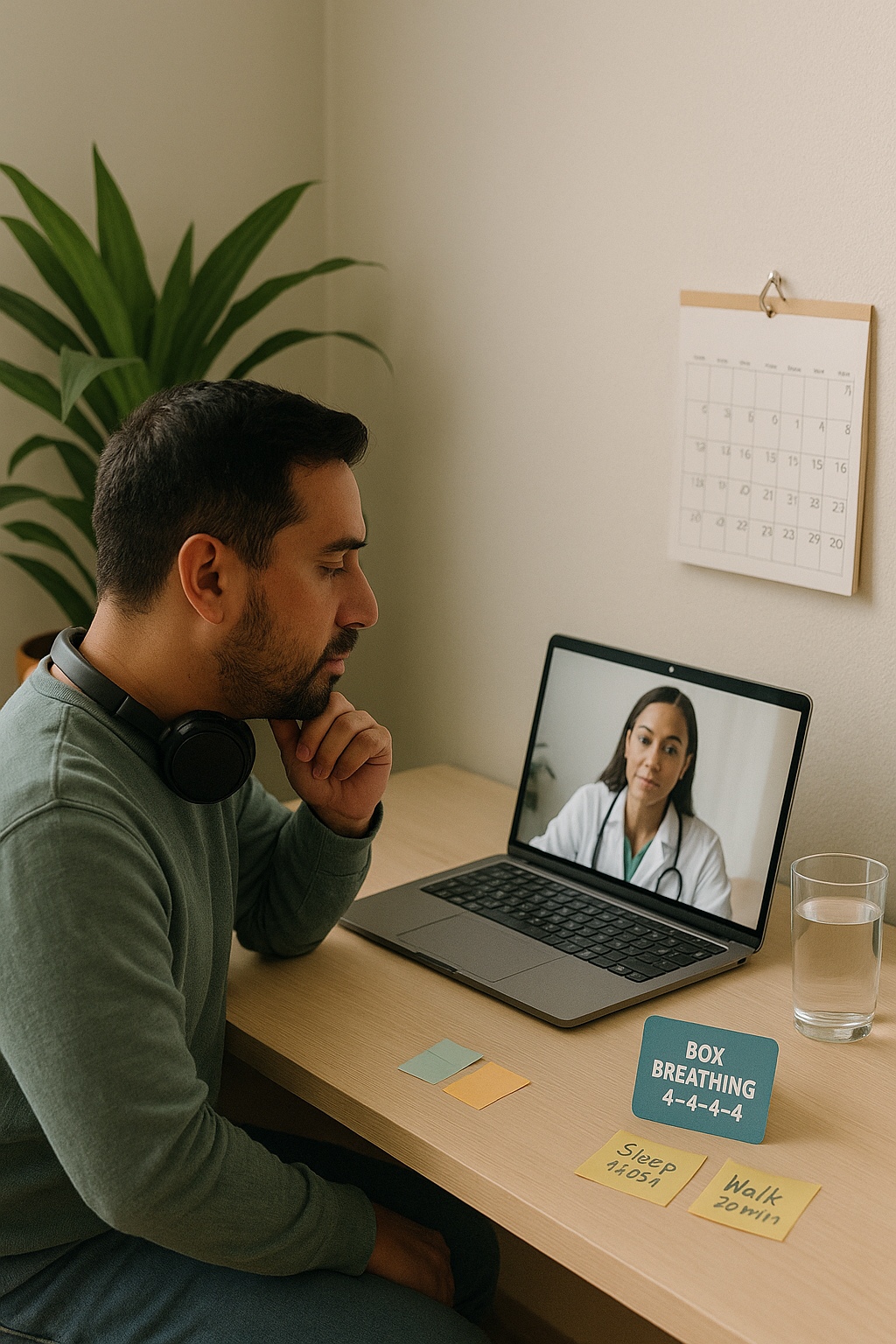Dealing With Stress? Try a Quick Telehealth Consult
- Home
- Dealing With Stress? Try a Quick Telehealth Consult

Dealing With Stress? Try a Quick Telehealth Consult
Estimated read time: 6–7 minutes
TL;DR: Stress is normal—being stuck in stress mode isn’t. A short telehealth visit can help you make a simple plan, learn fast-acting calm techniques, adjust sleep/caffeine habits, and decide whether therapy or medication could help. If you’re in immediate danger or thinking about harming yourself, call 988 (US) or your local emergency number now.
When a quick video visit helps
- You’re tense, overwhelmed, or not sleeping well
- Worries keep looping and you can’t “turn it off”
- Stress is causing headaches, stomach issues, chest tightness, or irritability
- You need a note for work/school, or ideas to juggle caregiving and life
- You want to learn calm skills and set a plan you can stick to
What a 15–20 minute consult looks like
- Your story: What’s stressing you, how long it’s been happening, how it affects sleep, focus, and relationships.
- Check basics: Caffeine, alcohol, medications/supplements, exercise, medical issues that can mimic stress (e.g., thyroid).
- Right-now toolkit: 1–2 breathing or grounding skills to use today, plus a simple sleep and screen plan.
- Next steps: Brief therapy options, self-guided programs, and whether medication is worth discussing.
- Follow-up: Usually in 2–4 weeks to fine-tune and keep you accountable.
Fast calm tools you can use today
- Box Breathing 4-4-4-4: Inhale 4, hold 4, exhale 4, hold 4 (2–3 minutes).
- 5–4–3–2–1 Grounding: Name 5 things you see, 4 feel, 3 hear, 2 smell, 1 taste.
- One-minute muscle release: Tense then relax shoulders, jaw, hands, and stomach.
- Worry window (10 minutes): Write worries once a day; outside that window, tell yourself “scheduled for later.”
- Move a little: A brisk 10–15 minute walk or light stretching lowers stress chemistry fast.
- Caffeine & phone curfew: No caffeine after noon; dim screens 1 hour before bed.
- Connection: Text/call one trusted person; name what’s hard and what you’ll try next.
A simple 7-day reset (repeat as needed)
Daily anchors
- Wake time within ±30 minutes
- 10 minutes of movement (walk, gentle cardio, or stretching)
- 2 calm breaks (breathing or grounding)
- 3 real meals with water at each
- Phone off the pillow: charge devices away from the bed
End-of-day check (2 minutes)
- What helped today?
- One thing to try tomorrow (make it tiny).
Sleep + stress: break the loop
- Keep the same wake time, even after a rough night.
- If you’re awake >20 minutes, get up, read something calm in dim light, and return to bed when sleepy.
- Avoid “catch-up” naps late in the day; if needed, keep naps <30 minutes and before 3 pm.
- Try a wind-down routine: shower, stretch, journal one page, lights low.
Therapy and medications—what to know
- Therapy works: Cognitive behavioral therapy (CBT), problem-solving therapy, and brief skills programs can be done by video.
- Self-guided options: Your clinician can recommend evidence-based apps or short online courses.
- Medication: Not everyone needs it. When appropriate, a clinician may discuss short-term options for sleep/anxiety or long-term medicines if symptoms meet criteria for an anxiety or depressive disorder. You’ll get clear guidance on benefits, side effects, and follow-up.
If work, school, or caregiving is the stressor
- Ask about a note for temporary adjustments (shifts, deadlines, class load).
- Practice “boundaries script”: “I can help with X today; I’ll revisit Y next week.”
- Use a two-column list: must-do vs. can-wait. Protect one small joy daily (walk, music, a call).
How to prep for your telehealth visit
- Top 3 problems you want help with (e.g., sleep, panic in meetings, constant worry).
- What you’ve tried (helped or not): apps, exercise, meds, supplements.
- Daily rhythm: caffeine/alcohol, exercise, bedtime/wake time.
- Medical history & meds (include supplements).
- Vitals if available (BP, heart rate, weight).
- Privacy plan: a quiet space and headphones.
After the visit
- You’ll get written instructions and a short plan for the next 1–2 weeks.
- Put calm breaks on your calendar like appointments.
- If meds were started/changed, note what you feel daily (better, worse, side effects).
- Schedule the follow-up so the plan keeps moving.
When to get urgent help (don’t wait)
- Thoughts about hurting yourself or someone else, or you feel unsafe → call/text 988 (US) or your local emergency number.
- Severe chest pain, trouble breathing, fainting, or new confusion.
- Symptoms of dangerous withdrawal (alcohol or benzodiazepines) or several days with no sleep at all.
How SendClinic can help
- Same-day video consults for stress management
- A practical plan you can start today, plus therapy referrals
- Medication discussions when appropriate, with clear follow-up
- Short check-ins every few weeks to keep you on track
Educational content only. This article isn’t a substitute for medical advice. Always follow your clinician’s guidance and local emergency instructions.
- Share